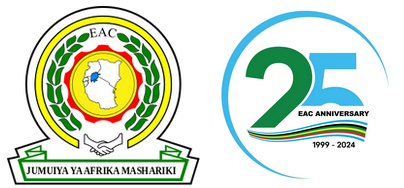Financial
Co-operation in monetary and fiscal matters in order to establish monetary stability within the Community, aimed at facilitating economic integration efforts and the attainment of sustainable economic development of the Community.A Regional Context
The origins of the East African Community (EAC) can be traced back to the long history of trade, administrative, and socio-cultural ties between Partner States, stretching back nearly a century. The EAC in its present form was formally created to include Kenya, Tanzania, and Uganda in 1999. In 2007, EAC membership was extended to Burundi and Rwanda.
The EAC implemented a Customs Union from the beginning of 2005. Another significant milestone was achieved with the signing of the Common Market Protocol in November 2009, ratified by all Partner States in April 2010. The agreement envisages the phased liberalisation of trade in financial services and the elimination of restrictions on the free movement of capital by 2015 at the latest.
Private Sector involvement
In addition to these institutional developments, the private sector has also played a major role in propelling regional financial integration in East Africa. Several banks that have operations in more than one Partner State have, to some degree, adopted a regional business model motivated by a range of factors including client-demand, their own corporate structures, and / or by opportunities perceived along the regional trade corridors. These banks display a fair degree of operational integration not just within EAC markets but all the way along the trade corridors to Southern Sudan and the Democratic Republic of Congo.
About 11 multinational and Kenyan owned banks use Kenya as a hub for their operations in the EAC region. There are four (4) Kenyan banks with branches within the region. These include Kenya Commercial Bank, Equity Bank, Fina Bank, and Commercial Bank of Africa. These banks have a total of 63 branches outside Kenya (16 in Tanzania, 31 in Uganda and 16 in Rwanda). Tanzania's CRDB Bank commenced operations in Burundi in 2012.
Among Kenyan insurance companies with branches within the region are APA Insurance, Insurance Company of East Africa, Jubilee Insurance, Phoenix of East Africa, Real Insurance and UAP Insurance. The estimated number of Kenyan insurance company branches within the region is about 30.
Several Kenyan stock broking firms have subsidiaries within the EAC region. These include Dyer and Blair Investment Bank (Uganda and Rwanda), Faida Securities (Rwanda) and Kingdom Securities (Rwanda). Each of these stockbrokers has only one branch in the regional countries they operate in.
Integration of Stock Exchanges
The integration of the EAC stock exchanges commenced in 2012. The first move to integrate the exchanges was to develop common automated trading and clearing platforms. This adoption is currently underway, with Uganda adopting the same automated trading system as that used by Kenya while Tanzania and Rwanda are expected to follow suit. Burundi does not yet have a stock exchange.
Prior to implementation of a common trading platform, cross-listing of shares in the EAC is already occurring and has increased private capital flows within the region. The total market capitalisation for cross listed shares in the EAC region stands at about US$2.88 billion, with 99.84 percent being taken up by the Nairobi Stock Exchange, whilst 0.16 percent is shared between the Dar Stock Exchange and the Uganda Stock Exchange. Currently, all companies cross-listed and trading regionally are headquartered in Kenya and, to date, there have been no cross-listings of companies based in other EAC countries.
